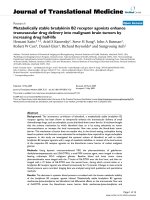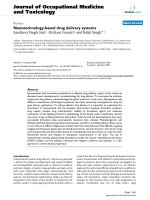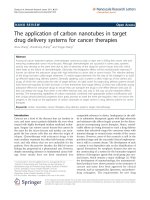Drug Delivery Systems
Bạn đang xem bản rút gọn của tài liệu. Xem và tải ngay bản đầy đủ của tài liệu tại đây (157.15 KB, 16 trang )
363
Drug Delivery Systems
Kevin M. Shakesheff
15.1
Introduction
The majority of medicines contain a polymer within their formulation. Polymers
play diverse roles in the pharmacy. For example, they act as wicking and disinte-
gration components of tablets, enteric coatings, and modifi ers of release kinetics,
lubricants, wetting agents, solid dispersion phases, viscosity modifi ers, penetra-
tion enhancers, and more. Biodegradable polymers, which undergo chain scission
as part of their function and prior to removal from the body, play a more limited
role than biostable polymers in medicines. Indeed, only two classes of biodegrad-
able polymers, poly( α - hydroxy acids) and polyanhydrides, have been used in mar-
keted products in the United States. Other classes of biodegradable polymers, for
example, polyorthoesters, having undergone decades of improvement, are now in
late - stage human trials.
The very limited number of polymer types that have been developed is sympto-
matic of the great challenge faced in developing new biodegradable polymers for
pharmaceutical applications. Additionally, the lack of new biodegradable polymers
joining the above classes also refl ects the ability to modify the properties of poly( α -
hydroxyl acids) and polyanhydrides using copolymer chemistry to match the
mechanical and degradation profi les required for many drug delivery applications.
One interesting characteristic of this fi eld of research is that so many groups have
based their research on a narrow range of polymer types over a long period that
a major body of literature exists on the chemistry, biological interactions, and
medical application of these polymers.
Despite the slow pace of development of new biodegradable polymers in the
fi eld of drug delivery, there is a need to accelerate research into new classes.
Current polymers have important weaknesses, and the requirements for biode-
gradable polymers that can release proteins, gene products, and cells are exposing
these weaknesses.
This chapter aims to provide an overview of the current state of knowledge of
poly( α - hydroxyl acids) and polyanhydrides to highlight the complexity of biological
interactions of even these relatively simple polymers. The chapter then looks at
Handbook of Biodegradable Polymers: Synthesis, Characterization and Applications, First Edition. Edited by
Andreas Lendlein, Adam Sisson.
© 2011 Wiley-VCH Verlag GmbH & Co. KGaA. Published 2011 by Wiley-VCH Verlag GmbH & Co. KGaA.
15
364
15 Drug Delivery Systems
some examples of research into new classes of biodegradable polymers that
address specifi c weaknesses in the current systems. The chapter does not attempt
to cover the entire range of biodegradable polymers under development as drug
delivery systems or to provide a complete history of the development of the poly( α -
hydroxyl acids) and polyanhydrides, but the reader is referred to more comprehen-
sive review articles throughout.
15.2
The Clinical Need for Drug Delivery Systems
Drug delivery systems modify the kinetics or the location of the escape of the drug
from the medicine. Tables 15.1 and 15.2 provide generic reasons for using drug
delivery systems.
For drug delivery systems containing biodegradable polymers, the major motiva-
tions for clinical use have been to deliver drugs that are required for long periods,
are rapidly removed by metabolism or excretion, and are required at sites of
administration that are diffi cult or impossible to reach with oral or conventional
injection routes [1] .
Cancer chemotherapy [2] and long - term replacement of human growth hormone
[3] have been the major clinical foci for research on biodegradable polymer applica-
tions. Zoladex is the most successful (in terms of duration of clinical use and
Table 15.1
Use of a drug delivery system for kinetic control.
Dissolution of drug is too slow
Drug and/or formulation is physically removed from the site of action too rapidly
Metabolism or excretion of the drug is too fast
Drug is required intermittently
Administration is complex, invasive, and/or costly and therefore, dosing frequency needs to
be reduced
Patient compliance (e.g., motivation to remember to take dosage) is poor and consequences
of missing dosages are serious
Table 15.2
Examples of motivations to use a drug delivery system for location control.
Avoid side effects by minimizing exposure of other tissues
Concentrate drug at the site of action
Avoid rapid metabolism or excretion from the body
Accelerate drug transport across cell membranes
The route of administration is technically diffi cult (e.g., injection)
15.3 Poly(α-Hydroxyl Acids)
365
number of patients treated) biodegradable polymer - based formulation [4] . The
primary clinical application of Zoladex LA is in the treatment of prostate cancer
with the luteinizing hormone releasing hormone antagonist goserelin acetate.
This drug blocks the downstream control of testosterone by the pituitary gland
and thereby starves the tumor of a hormone that stimulates cancer growth. Gos-
erelin acetate is a peptide molecule that can only be delivered by injection (it would
be metabolized in the gastrointestinal track by enzymes). In addition, the drug
needs to be constantly present in the blood stream for extended periods (e.g., 3
months). The polymer science underlying the release of drug from Zoladex, and
the related product Lupron, is explored in Section 15.3.1 .
Biodegradable polymer systems have also been employed for over a decade in
the treatment of glioblastoma multiforme, an aggressive tumor within the brain
[5 – 7] . In common with Zoladex, the systems used glioblastoma multiforme need
to deliver drug over extended periods of time. Gliadel is a polyanhydride - based
delivery system of the drug, 5 - nitrourea, that concentrates the drug at the site of
the tumor. In contrast to Zoladex, Gliadel provides local delivery of a toxic drug
that must not be delivered to other sites in the body. The Gliadel product is placed
at the site of the original tumor at the end of surgery to remove the primary tumor.
Therefore, Gliadel achieves both temporal and spatial control of the release of a
potent and toxic chemotherapy.
15.3
Poly( α - Hydroxyl Acids)
Polymers composed of lactic acid and glycolic acid dominate scientifi c literature
on biodegradable polymers for drug delivery.
Polylactic acid:
*
O
*
O
n
Polyglycolic acid:
*
O
*
O
n
*
O
*
O
n
These polymers are synthesized by ring - opening polymerization of lactide and
glycolide. In terms of nomenclature, the polymers are often termed polylactide,
polyglycolide, and polylactide - co - glycolide as this refl ects the monomer chemistry.
However, the abbreviations PLA, PGA, and PLGA are more widely used than PL,
PG, and PLG, and thus in this chapter polymer names including the acid term
are used. It is very important to always specify the stereochemistry of the lactic
366
15 Drug Delivery Systems
acid component (see Section 15.3.1 ) as it has a profound effect on the physical and
biological behavior of these polymers.
The polymers in this family have been components of biodegradable sutures
and orthopedic implants for many years providing a long history of use in the
human body. PLGA systems possess many attributes that make them suitable for
drug delivery applications in which a slow release of a drug within a device is
required [8] . Principle attributes are given below:
1 ) Ability to control the kinetics of polymer degradation
For detailed explanation of control, see review by Anderson and Shive [6] and
papers of Vert et al. [7 – 13] , for example, A summary of key features of methods
of control are discussed below.
2 ) Numerous routes to fabrication
Described in Section 15.6.4.
3 ) Mechanical properties
Suffi cient compressive and tensile strength for use in applications in which
the delivery system will be under compression or tension during function.
For example, the polymer class is used in orthopedic implants.
4 ) Widely available at medical grade
Synthesized to high purity and following good manufacturing practice by a
number of companies across the world.
The history of use of PLGA polymers provides a number of important lessons for
the development of new classes of polymers. Despite the simplicity of the polymer
chemistry of PLGA polymers, the broad use of these polymers in humans and
animal models has exposed signifi cant complexity in the behavior of these poly-
mers in vivo . Section 15.3.1 highlights some of the complexity and draws heavily
on the excellent review of Anderson and Shive [8] .
15.3.1
Controlling Degradation Rate
There are two distinct steps in the breakdown and removal of a biodegradable
polymer; degradation and erosion. Degradation is the chemical breakage of bone
along the polymer backbone that results in a decrease in polymer molecular
weight. Erosion is the loss of mass from the delivery system due to the dissolution
of the products of degradation.
The kinetics of degradation and erosion are determined by chemical and physi-
cal properties of the drug delivery system. A major attraction of the poly( α - hydroxy
acids) is the ability to use the ratio of lactic acid to glycolic acid in the polymer
chain to control both sets of kinetics. The methyl group on the lactic acid monomer
retards hydrolysis of the neighboring ester group compared with the glycolic acid
structure [9] . Hence, lactic acid containing homopolymers may take over one year
to degrade and erode, while PGA may degrade and erode in one month. It is
important to note that the exact period of time for degradation and erosion is not
stated exactly because there are competing physical factors that can greatly acceler-
ate or retard biodegradation. A study published by Beck et al. in 1983 demonstrates
the effect of lactic acid to glycolic acid ratio on biodegradation and is reproduced
in Figure 15.1 [10] .
The next issue to be considered is the stereochemistry of the carbon - alpha to
the ester [11, 12] . Clearly, both d and l forms of lactic acid exist, with l being the
form used in nature. Lactic acid - based polymers are synthesized by the ring -
opening polymerization of lactide. For drug delivery applications, both d,l - lactide
and l - lactide are used. Hence, poly( d,l - lactic acid) ( P
DL
LA ) and poly( l - lactic acid)
( P
L
LA ) and both sterochemistries may be incorporated into PLGA copolymers.
P
L
LA and PGA are semicrystalline, while P
DL
LA is amorphous. The degree of
crystallinity affects the rate of water penetration into the drug delivery system and
hence the rate of biodegradation. P
L
LA may take more than 2 years to degrade in
vivo if a semicrystalline morphology is allowed by the manufacturing route, while
P
DL
LA is removed in approximately 1 year. Li and Vert described a further com-
plication in that the degree of crystallinity of quenched P
L
LA (starting point amor-
phous due to quenching) and inherently amorphous P
DL
LGA increased during
degradation due to reorganization of the degradation products prior to, and delay-
ing, erosion [13, 14] .
When predicting the kinetics of degradation and erosion of PLGA polymers, it
is necessary to consider the balancing contributions of polymer chemistry and
crystallinity. For example, P
DL
LGA (50:50) degrades and erodes more rapidly than
PGA because the rate of penetration of water is the rate - limiting step rather than
the steric hindrance to hydrolysis of the monomer structure.
Figure 15.1
In vivo biodegradation of microcapsules is measured by Beck et al. by measuring
radiolabeled P
DL
LGA. Reproduced with permission from [10] .
100
90
80
70
60
50
Radioactivity recovered
% of radioactivity recovered at zero time
40
30
20
10
05101520
Time (wk)
25
DL-PLGA EXCIPIENT
A
B
C
D
96:4
92:8
87:13
74:26
30 35 40 45
0
15.3 Poly(α-Hydroxyl Acids)
367
368
15 Drug Delivery Systems
A further complication in predicting and understanding the kinetics of degrada-
tion of this family of polymers is the effect of device size and architecture. Coun-
terintuitively large device made from PLGA degrade more rapidly than
microparticles in certain circumstances [15] . In addition, an important clue in the
mechanism of accelerated degradation of large devices is the fi nding that large
rods of PLGA often become hollow during degradation. These phenomena can be
explained by the process of autocatalysis in which the acidic degradation products
of PLGA hydrolysis accelerate local degradation. This localized catalysis is greatest
within large devices due to the slow escape of the acid species. Hence, heterogene-
ous degradation kinetics occur across devices that have a diameter or width
> 300 μ m.
15.4
Polyanhydrides
The second class of biodegradable polymers approved for use in humans in a drug
delivery application are the polyanhydrides. The product Gliadel has been used for
the treatment of brain tumors (see Section 15.2 ). A comprehensive review has
been published by Katti et al. [16] .
The motivation for using polyanhydrides over poly( α - hydroxy acids) is the need
to restrict polymer erosion to the surface of the devise. As described in Section
15.3 , the PLGA systems erode through a bulk mechanism for small particles and
an autocatalytic hollowing mechanism for large rods. These mechanisms result
in the encapsulated drug contacting with water for extended periods before the
drug is released. Therefore, drugs that are sensitive to hydrolysis or other water -
mediated instabilities could lose activity over time in the PLGA devices. A surface -
eroding device would keep the drug dry prior to release. A further advantage of
a surface - eroding system is the ability to control drug release kinetics via changes
in surface area of the delivery system. For PLGA systems, the relationship
between polymer degradation, drug release, and surface area is very diffi cult to
predict (because bulk effects dominate and can be erratic due to physical breakup
of the delivery system).
The Gliadel system is formed from a copolymer of the monomers
bis(carboxyphenoxy)propane ( CPP ) and sebacic acid ( SA ). The structures of these
monomers and the generic anhydride structure are shown below. Although no
other polyanhydrides have been used in approved pharmaceutical products to date,
the fi eld of polyanhydride chemistry is active, and promising new structures are
under investigation.
General PAA structure:
*
R
O
*
O
O
n









